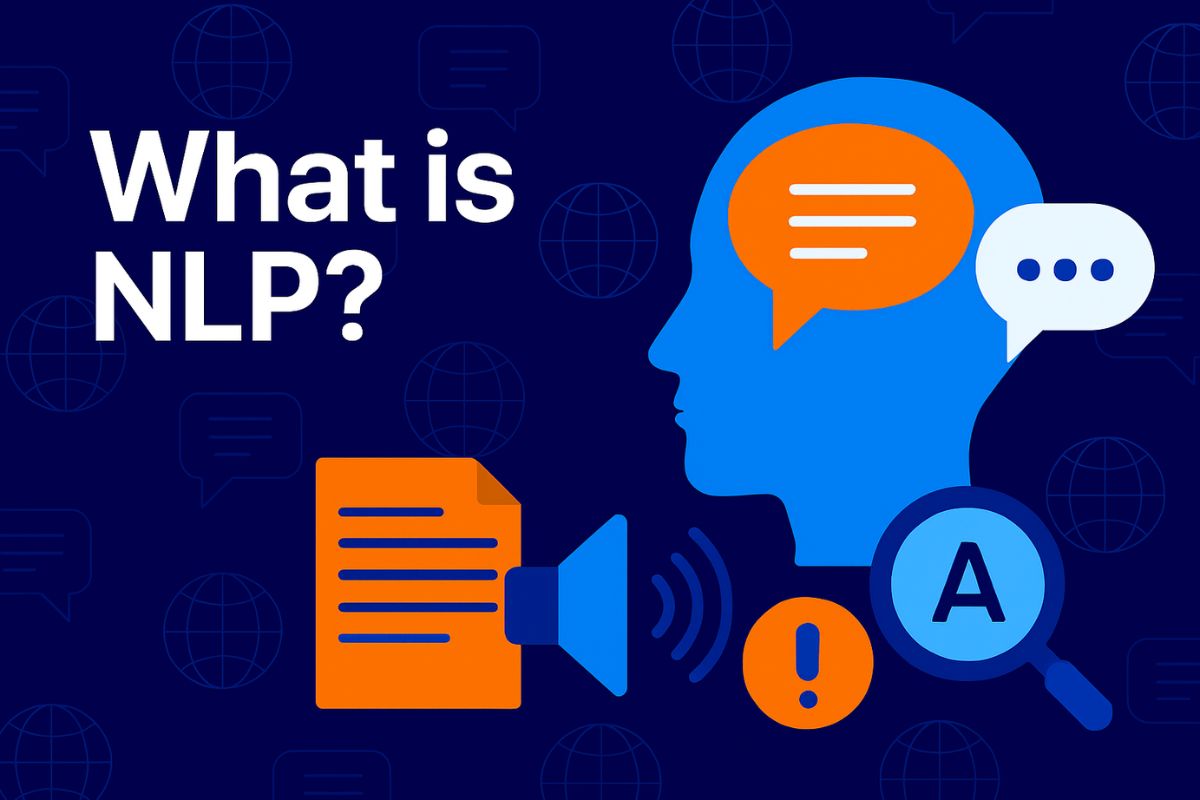Natural Language Processing (NLP) enables computers to understand, interpret, and generate human language. This technology powers voice assistants, chatbots, translation apps, and much more. This guide explains how NLP works, key techniques, applications globally and in India, benefits, challenges, career opportunities, and learning resources for 2025.
Have you ever wondered how virtual assistants like Alexa, Siri, or Google Assistant understand your commands or how Google Translate works? The magic behind these is Natural Language Processing (NLP) — a fascinating branch of artificial intelligence that allows machines to process and understand human language.
NLP bridges the gap between human communication and computer understanding, making interactions smoother and more intuitive. From chatbots helping customers 24/7 to automated translation services breaking language barriers, NLP is transforming industries worldwide, including India’s booming digital ecosystem.
We will explore what NLP is, how it functions, its important techniques, real-world applications, challenges, career paths, and resources for anyone eager to dive into this exciting field.
How Does NLP Work?
Natural Language Processing involves teaching computers to understand, interpret, and generate human languages. Unlike structured data like numbers, human language is ambiguous, nuanced, and complex, making NLP a challenging task.
Core Components
- Text Preprocessing: Cleaning raw text by removing stopwords, punctuation, and performing normalization (lowercasing, stemming, lemmatization).
- Tokenization: Splitting text into smaller units like words or sentences.
- Parsing: Analyzing the grammatical structure of sentences.
- Semantic Analysis: Understanding the meaning and context behind words and sentences.
Modern NLP uses machine learning and deep learning techniques, especially models like transformers (e.g., GPT, BERT), to handle language understanding more effectively.
Key NLP Techniques
Sentiment Analysis
Detects emotions and opinions from text, used in product reviews and social media monitoring.
Named Entity Recognition (NER)
Identifies and classifies entities like names, dates, locations in text.
Machine Translation
Automatically translates text from one language to another (Google Translate).
Speech Recognition
Converts spoken language into text, powering voice assistants.
Text Summarization
Creates concise summaries from long documents.
Chatbots and Conversational AI
Enables machines to conduct human-like conversations.
Applications of NLP
Global Use Cases
- Virtual Assistants and Chatbots: Helping users with queries and support 24/7.
- Automated Customer Support: Reducing wait times with AI-powered agents.
- Social Media Monitoring: Analyzing trends and public sentiment.
- Healthcare: Analyzing medical records and research papers.
India-Specific Use Cases
| Sector | Example & Description |
|---|---|
| Customer Service | Indian banks and telecom companies using chatbots for support |
| Language Translation | Tools supporting India’s many languages, enabling better communication |
| Education | Automated grading systems and language learning apps |
| Government Services | AI-powered helplines handling citizen queries in multiple languages |
Benefits of NLP
- Improved Human-Machine Interaction: Natural conversations without complex commands.
- Automation of Routine Tasks: Saves time in customer service and document processing.
- Data Insights: Extracts useful information from large volumes of text.
- Language Inclusion: Supports multiple languages and dialects, crucial for India’s diversity.
Challenges of NLP
| Challenge | Description |
|---|---|
| Language Diversity | Handling India’s 20+ official languages and numerous dialects |
| Ambiguity | Words with multiple meanings, sarcasm, idioms |
| Context Understanding | Grasping nuances and context in conversations |
| Data Privacy | Ensuring sensitive text data is handled securely |
Popular NLP Tools and Frameworks (2025)
| Tool/Framework | Key Features | Use Cases | License |
|---|---|---|---|
| NLTK | Python library for basic NLP tasks | Education, research | Open source |
| spaCy | Industrial-strength NLP in Python | Production NLP systems | Open source |
| Google BERT | Pre-trained transformer model | Text classification, Q&A | Open source |
| Hugging Face Transformers | State-of-the-art NLP models | Chatbots, translation | Open source |
Career Opportunities in NLP
- NLP Engineer: Designing algorithms for language understanding.
- Data Scientist (NLP focus): Analyzing text data and building models.
- Computational Linguist: Applying linguistics to improve NLP models.
- AI Researcher: Developing advanced language models.
- Product Manager: Leading NLP-based product development.
Salary Insights
| Role | Avg Salary in India (₹/year) | Avg Salary Globally (USD/year) |
|---|---|---|
| NLP Engineer | ₹7–15 LPA | $90K–140K |
| Data Scientist | ₹6–14 LPA | $80K–130K |
| Computational Linguist | ₹5–12 LPA | $70K–120K |
How to Learn NLP
Recommended Skills
- Programming languages: Python, R
- Machine Learning & Deep Learning
- Linguistics basics
- Familiarity with NLP libraries like NLTK, spaCy, TensorFlow, PyTorch
Learning Resources
- Courses:
- Coursera – Natural Language Processing Specialization
- Udemy – NLP with Python
- edX – AI for Everyone
- Practice:
- Kaggle NLP competitions
- Building chatbot projects
- Contributing to open source NLP tools
FAQs
1. What is Natural Language Processing?
NLP is the branch of AI that helps computers understand and generate human language.
2. How is NLP used in everyday life?
From voice assistants and chatbots to translation apps and spam filters, NLP is everywhere.
3. Can NLP understand all languages?
NLP works best on widely spoken languages but is improving rapidly for regional languages.
4. What programming languages are used in NLP?
Python is the most popular, followed by R and Java.
5. Is NLP difficult to learn?
It requires knowledge of programming, linguistics, and machine learning but is approachable with practice.
6. How is NLP different from general AI?
NLP focuses specifically on language, while AI covers a broad range of intelligent behaviors.
7. What are future trends in NLP?
More context-aware models, better handling of low-resource languages, and integration with other AI fields.



